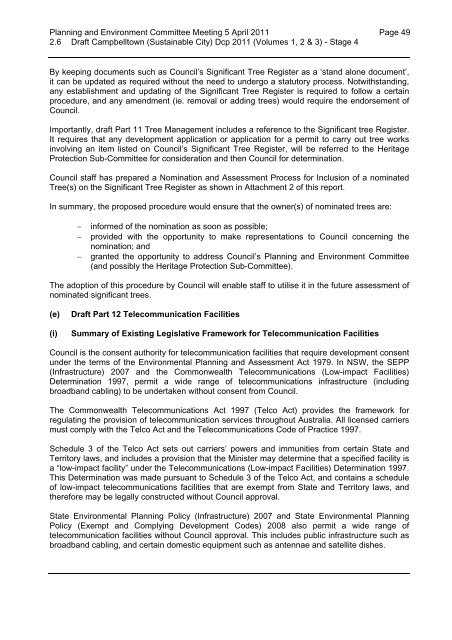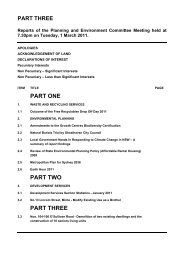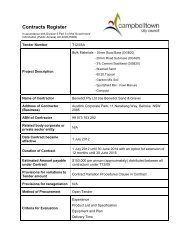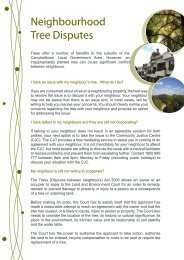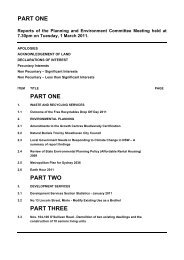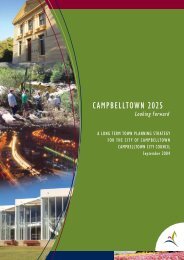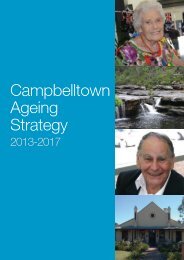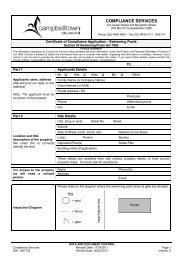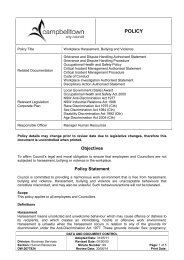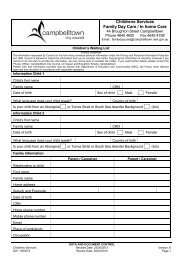PART ONE - Campbelltown City Council - NSW Government
PART ONE - Campbelltown City Council - NSW Government
PART ONE - Campbelltown City Council - NSW Government
You also want an ePaper? Increase the reach of your titles
YUMPU automatically turns print PDFs into web optimized ePapers that Google loves.
Planning and Environment Committee Meeting 5 April 2011 Page 492.6 Draft <strong>Campbelltown</strong> (Sustainable <strong>City</strong>) Dcp 2011 (Volumes 1, 2 & 3) - Stage 4By keeping documents such as <strong>Council</strong>’s Significant Tree Register as a ‘stand alone document’,it can be updated as required without the need to undergo a statutory process. Notwithstanding,any establishment and updating of the Significant Tree Register is required to follow a certainprocedure, and any amendment (ie. removal or adding trees) would require the endorsement of<strong>Council</strong>.Importantly, draft Part 11 Tree Management includes a reference to the Significant tree Register.It requires that any development application or application for a permit to carry out tree worksinvolving an item listed on <strong>Council</strong>’s Significant Tree Register, will be referred to the HeritageProtection Sub-Committee for consideration and then <strong>Council</strong> for determination.<strong>Council</strong> staff has prepared a Nomination and Assessment Process for Inclusion of a nominatedTree(s) on the Significant Tree Register as shown in Attachment 2 of this report.In summary, the proposed procedure would ensure that the owner(s) of nominated trees are:informed of the nomination as soon as possible;provided with the opportunity to make representations to <strong>Council</strong> concerning thenomination; andgranted the opportunity to address <strong>Council</strong>’s Planning and Environment Committee(and possibly the Heritage Protection Sub-Committee).The adoption of this procedure by <strong>Council</strong> will enable staff to utilise it in the future assessment ofnominated significant trees.(e)(i)Draft Part 12 Telecommunication FacilitiesSummary of Existing Legislative Framework for Telecommunication Facilities<strong>Council</strong> is the consent authority for telecommunication facilities that require development consentunder the terms of the Environmental Planning and Assessment Act 1979. In <strong>NSW</strong>, the SEPP(Infrastructure) 2007 and the Commonwealth Telecommunications (Low-impact Facilities)Determination 1997, permit a wide range of telecommunications infrastructure (includingbroadband cabling) to be undertaken without consent from <strong>Council</strong>.The Commonwealth Telecommunications Act 1997 (Telco Act) provides the framework forregulating the provision of telecommunication services throughout Australia. All licensed carriersmust comply with the Telco Act and the Telecommunications Code of Practice 1997.Schedule 3 of the Telco Act sets out carriers’ powers and immunities from certain State andTerritory laws, and includes a provision that the Minister may determine that a specified facility isa “low-impact facility” under the Telecommunications (Low-impact Facilities) Determination 1997.This Determination was made pursuant to Schedule 3 of the Telco Act, and contains a scheduleof low-impact telecommunications facilities that are exempt from State and Territory laws, andtherefore may be legally constructed without <strong>Council</strong> approval.State Environmental Planning Policy (Infrastructure) 2007 and State Environmental PlanningPolicy (Exempt and Complying Development Codes) 2008 also permit a wide range oftelecommunication facilities without <strong>Council</strong> approval. This includes public infrastructure such asbroadband cabling, and certain domestic equipment such as antennae and satellite dishes.


